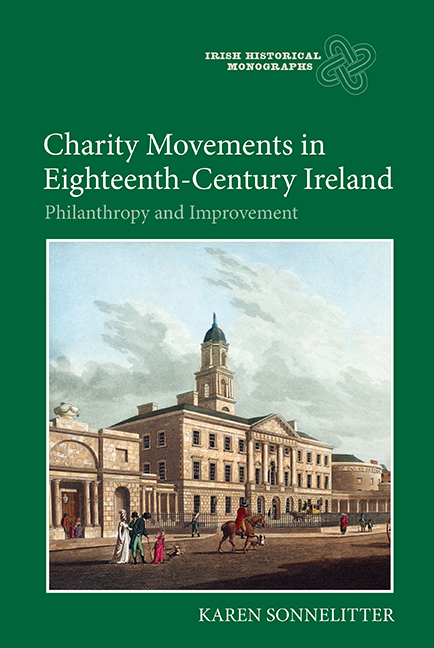Book contents
- Frontmatter
- Dedication
- Contents
- List of Figures
- Acknowledgements
- Abbreviations
- Introduction: Ireland in the Eighteenth Century: The Case for Improvement
- 1 ‘The Worst in Christendom’: The Church of Ireland and Improvement
- 2 Education and Charity: The Incorporated Society for Promoting English Protestant Schools in Ireland
- 3 To Cure and Relieve: Voluntary Hospitals in Eighteenth-Century Dublin
- 4 Improvement as Philanthropy: The Royal Dublin Society
- 5 ‘The Benevolent Sympathies of the Female Heart’: Women, Improvement, and the Work of Lady Arbella Denny
- 6 National and Local Government and Improvement
- Conclusion: Philanthropy and Improvement in Eighteenth-Century Ireland and Beyond
- Bibliography
- Index
3 - To Cure and Relieve: Voluntary Hospitals in Eighteenth-Century Dublin
Published online by Cambridge University Press: 11 May 2021
- Frontmatter
- Dedication
- Contents
- List of Figures
- Acknowledgements
- Abbreviations
- Introduction: Ireland in the Eighteenth Century: The Case for Improvement
- 1 ‘The Worst in Christendom’: The Church of Ireland and Improvement
- 2 Education and Charity: The Incorporated Society for Promoting English Protestant Schools in Ireland
- 3 To Cure and Relieve: Voluntary Hospitals in Eighteenth-Century Dublin
- 4 Improvement as Philanthropy: The Royal Dublin Society
- 5 ‘The Benevolent Sympathies of the Female Heart’: Women, Improvement, and the Work of Lady Arbella Denny
- 6 National and Local Government and Improvement
- Conclusion: Philanthropy and Improvement in Eighteenth-Century Ireland and Beyond
- Bibliography
- Index
Summary
In 1758 a young man named William Carey arrived at Mercer's Hospital in Dublin. He was recommended for admission by the Reverend William Henry. It was a long journey for the nineteen-year-old Carey, who had lived up until then on an isolated island in Lough Melvill in County Leitrim. A year earlier he had begun to experience bizarre symptoms. At first it was a sudden swelling in his right wrist. Soon the swelling turned hard and that hardness began to spread up his arm. Carey's muscles were ossifying. Reverend Henry observed that a kind of jelly first oozed out of his joints, which then gradually turned into bone. The severity of his disorder required more advanced medical treatment than was available in Carey's remote island home. He had to travel to receive any treatment, which brought him first to Castle Caldwell in County Fermanagh, to be evaluated by Reverend Henry and Sir James Caldwell. From there Henry transported him to Dublin and had him admitted to Mercer's Hospital for treatment. There the physicians and surgeons of the hospital treated him with mercury, both orally and as plasters applied to his skin. The course of treatment seemed to help stop the spread of the ossification and to ease his joints, but little could be done about those areas already affected. Carey was instructed to bathe twice daily in the ocean near his home and to continue using the mercurial plasters on the affected areas.
The eighteenth century brought many medical advances, but there was still little physicians could do to actually cure the sick, particularly with a case as unusual as Carey’s. There was a widespread belief in the medical benefits of mercury and the therapeutic value of the seaside and, for Carey at least, they seemed to provide some relief. Carey, and others like him, had few options when it came to receiving medical treatment. Medical facilities were scarce in Ireland in the eighteenth century. There were none on the small island in County Leitrim where Carey was born, and he was not wealthy enough to afford a private physician, even if one had lived nearby.
- Type
- Chapter
- Information
- Charity Movements in Eighteenth-Century IrelandPhilanthropy and Improvement, pp. 76 - 98Publisher: Boydell & BrewerPrint publication year: 2016



